Zendikar Rising to the Challenge, Part 2
Last week, I began previewing Zendikar Rising and talking about how the set got designed. There's more to tell and more to preview, so let's continue with the story.
Double the Fun
Party isn't the only new mechanic being introduced in Zendikar Rising, so I want to walk you through how the other new mechanic came to be. Interestingly, it's an idea I've had for a long time. Flashback to the design of Innistrad. (It's better than being morbid about it.) We were trying to create the most awesome mechanical execution of Werewolves that we could when design team member Tom LaPille shared something that they'd done on our Duel Masters trading card game—double-faced cards. It ended up being the perfect fit, and "dark transformation" became a major theme of the set.
As we were designing double-faced cards, I and multiple other designers on the team designed some cards that worked a little differently than our transforming DFCs. Rather than casting or playing side A and transforming it into Side B, these cards let you choose whether to cast or play Side A or Side B. They were basically a split card execution of double-faced cards. We called them modal double-faced cards (MDFC) in contrast to transforming double-faced cards (TDFC).
A quick aside. Let me quickly run you through how to talk about double-faced cards (well, at least how we're going to talk about them) in the world of the new ones in Zendikar Rising. The ones that premiered in Innistrad (and are all the ones we've done up until now) are transforming double-faced cards. That is, you can only cast Side A and you transform into Side B. If you want to refer specifically to them, you'd say TDFC. The ones in Zendikar Rising are modal double-faced cards. That is, you can choose to cast either Side A or Side B. If you want to refer specifically to them, you'd say MDFC. If you're talking about all of them, you would say DFC. Now, if you're talking about a subset and it's clear which ones you mean ("The DFCs in Zendikar Rising"), you can shortcut to just saying DFCs. Back to the story.
As double-faced cards were a new thing (and thus required some player education for how to use them) and "dark transformation" was our theme, I felt it was important to only use transforming double-faced cards in original Innistrad block. I had modal double-faced cards in my back pocket. I could use them later.
That was probably 2010 (Innistrad came out in 2011). So, what took so long? A number of things. First, I always like to premiere a mechanic in a set that can play into the strength of that mechanic, so I get a little extra picky about where I use it. If a mechanic is loved when it premieres, we get to use it many more times. If it's hated (or even just creates disinterest), that often can be its only appearance. Second, adding double-faced cards to a set adds extra logistical issues, so I have to make sure that their addition is worth the trouble. Third, there are just a lot of things we're juggling. For example, there are many mechanics I'm looking to find a home for. This means that any one idea can sit around for a while.
Flashforward to an offsite where we were planning the next three years' worth of sets. Most of the sets started from a world we wanted to build, either because it was something the playerbase has been asking for (such as doing a top-down Norse mythology-inspired set) or because it was a cool speculative world the Creative team had pitched (such as a monster world). Aaron asked me if there was a world that I wanted to do that was a bottom-up world based on a mechanic I wanted to do. I said there was. I explained MDFCs and told them the type of world I thought we could build around it. Everyone signed off on it, and it was added to the schedule. That set would become
About a year before Strixhaven: School of Mages exploratory design was about to start, Aaron Forsythe, my boss, came to me and said that there was some concern about MDFCs. Some of R&D felt it wasn't a good idea to do them, and when that happens, upper management will enquire about it. ("Why are people against it?") I said they were a cross between transforming double-faced cards, which the majority of the players loved, and split cards, which the majority of the players loved. Yes, there's always a chance that you can combine two beloved things and make something unbeloved, but we take chances all the time on new mechanics, and this seemed well above any bar of risk we had to clear. Aaron said he agreed, that he wouldn't have greenlit the set if he didn't believe in it. He just wanted me to start a mini design team to design some MDFCs so that he had something tangible to show people. It's one thing to argue for an unrealized concept and another to show tangible proof of the execution. Also, having real cards would allow us to playtest them and do market research on them to get data. Data is the best way to quiet skeptics in R&D.
So, I put together a few weeks of meetings, and we made some MDFCs. We made a lot of MDFCs, a surprisingly large amount actually. I showed them off to Aaron, and he was able to use them to help quiet most of the skepticism. The thing that seemed to seal the deal, interestingly, was a bunch of MDFC designs I'd made years earlier (I tracked down all my old designs from our mini team)—a ten-card cycle I'd made of MDFC dual lands. The moment people saw those, they were like, "We have to make these." (Six of them appear in Zendikar Rising, with the remaining four appearing in Kaldheim.)

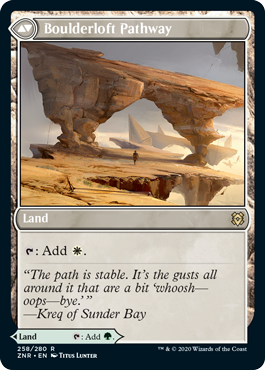

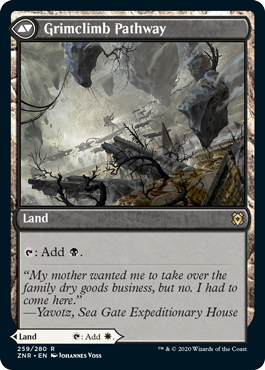
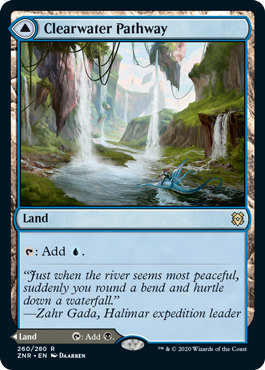
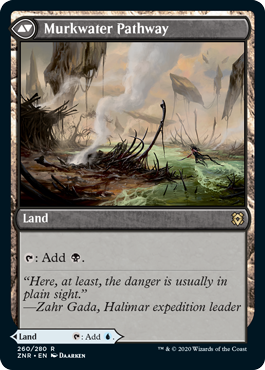
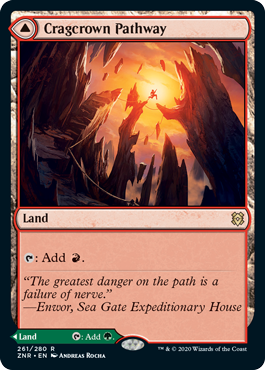
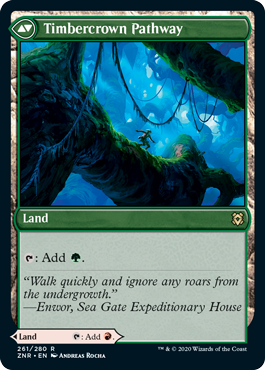
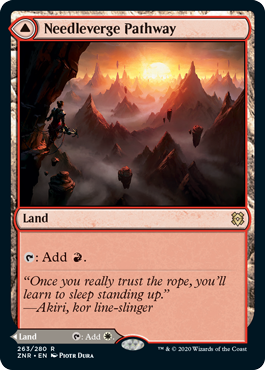
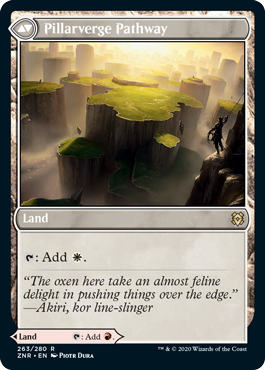
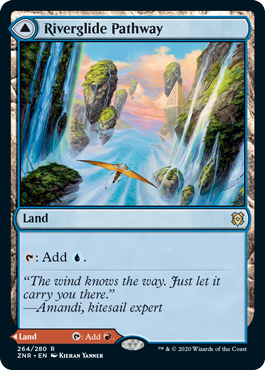
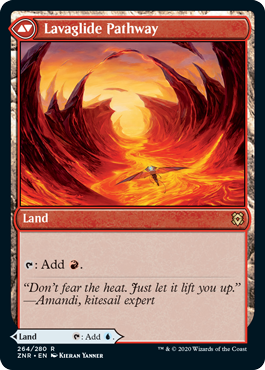
A separate issue that I'd been wrestling with is that I've been trying to find more ways to tie together the three non-core premier sets in a single Magic "year" (aka the fall, winter, and spring sets—using northern hemisphere seasons). For decades, we'd had the block model, which always tied them together, but since we'd stopped doing it, the sense of a Magic year has started to drift away (except for the shared rotation). I've been looking for different ways to tie the three sets together, and the MDFCs gave me an idea. There was a lot of design space available. What if each set used MDFCs, but in a slightly different way, using the mechanic to play up the theme of that set?
For example, Zendikar Rising was a land-themed set. What if all of its MDFCs had a land on at least one side? You could have this spell or a land of the appropriate color? Or you could choose between two lands? There was plenty of designs to fill up the set. I can't yet say what we're doing with the MDFCs in Kaldheim or Strixhaven: School of Mages, but each set has found cool designs to use the new mechanic in a way that enhances what it's about.
For Zendikar Rising, this means that every MDFC lets you choose between playing land or playing another card. Many times, that other card is a spell, and sometimes, it's another land. That land will always tap for a single-color mana, and on all the common, uncommon, and some of the higher rarity ones, the land enters the battlefield tapped. The other side can be a creature, an instant, a sorcery, or a land.
In any zone other than the stack or the battlefield, the card is considered to be on Side A. That is signified by the symbol in the upper left-hand corner with a single triangle. Two triangles indicate it's Side B.
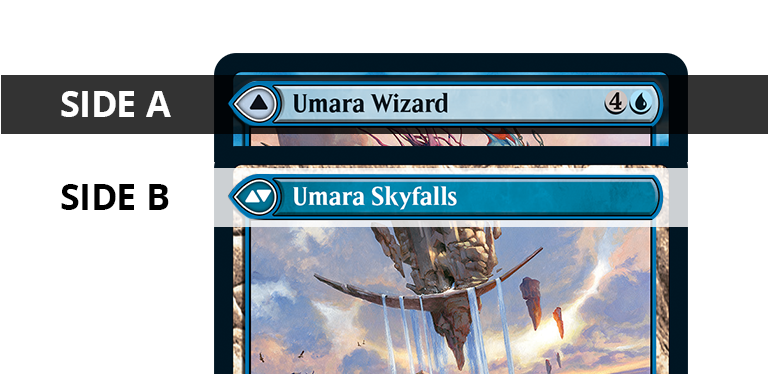
For example, let's say you have Umara Wizard or Umara Skyfalls.
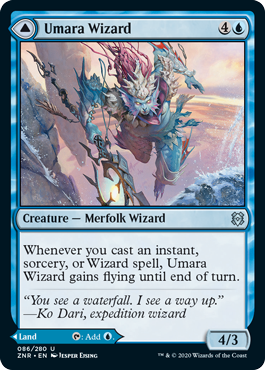
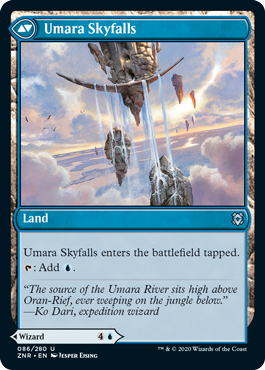
In exile, hand, graveyard, or library, it's considered to be Umara Wizard and not Umara Skyfalls. For example, that means you can use a spell that gets a creature out of your graveyard to return Umara Wizard to your hand, but you can't use a spell that gets a land out of your graveyard to get Umara Skyfalls back. Likewise, you can search your library for a creature card to get Umara Wizard into your hand, but you can't search for a land to get Umara Skyfalls into your hand. If a card calls for you to discard a creature card, you can discard Umara Wizard, but you can't discard Umara Skyfalls for a card that calls for you to discard a land.
On the stack or the battlefield, the card is whatever it was cast or played as. For instance, if you chose to play the card as Umara Skyfalls, it's a land on the battlefield. A land destruction spell can destroy it, but not a creature destruction spell. If you bounce that land back to your hand, it will turn back into an Umara Wizard card, but you will be free to play it as Umara Skyfalls when you next get a chance to play a land.
You will notice that at the bottom left of the card, it will give you a mana cost (if there is one) and a small amount of information about the other side.
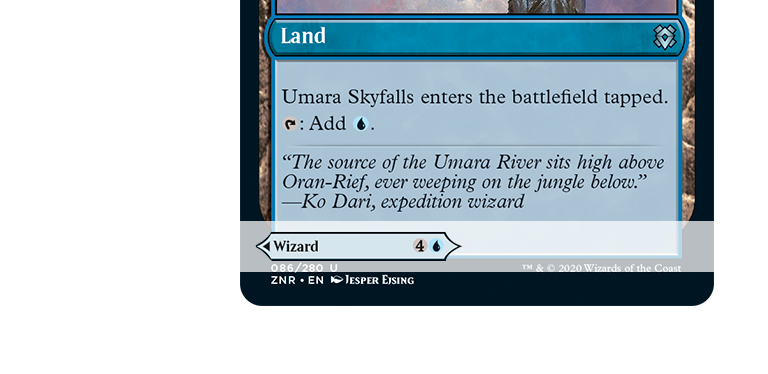
I've been wanting to make MDFCs for a long time, so I'm excited to see you all finally get to play with them.
Something Old, Something Old
Now that I've talked about the new mechanics, let's start talking about the returning mechanics. Whenever we return to a plane, I always have an early vision design meeting where we write down every mechanic from any previous expansion set on that world. For Zendikar, that meant Zendikar, Worldwake, Rise of the Eldrazi, Battle for Zendikar, and Oath of the Gatewatch.
Here are all the named mechanics from those sets (with a few higher profile unnamed ones thrown in):
Annihilator
Awaken
Cohort
Colorless Mana
Converge
Devoid
Eldrazi Spawn token creatures/Eldrazi Scion token creatures
Ingest
Kicker/Multikicker
Landfall
Level-Up
"Creature Lands" (lands that self-animate)
Processors
Quests
Rally/Allies
Rebound
Support
Surge
Totem Armor
Traps
The first thing we had to do was remove any mechanics tied to the Eldrazi as they were no longer here. That leaves us with:
Awaken
Cohort
Converge
Kicker/Multikicker
Landfall
Level-Up
"Creature Lands" (lands that self-animate)
Quests
Rally/Allies
Rebound
Support
Surge
Totem Armor
Traps
Next, we need to remove mechanics tied to the denizens working together or teaming up as that's the role and flavor that party was playing in the set. That leaves us with:
Awaken
Kicker/Multikicker
Landfall
Level-Up
"Creature Lands" (lands that self-animate)
Quests
Rebound
Totem Armor
Traps
We then walked through what was left. We labeled each Yes, Maybe, or No.
Awaken – The mechanic was in Battle for Zendikar to represent that even the land itself was rising up against the Eldrazi. The flavor is a little off, but the mechanic played well, was generally liked, and clearly ties into Zendikar's land theme. (Maybe)
Kicker/Multikicker – The reason these both showed up in past Zendikar sets is that land-centric themes tend to promote playing more lands, which tends to end up providing the players with more mana, making mana sink mechanics useful. (Maybe)
Landfall – Landfall is both beloved and intrinsically tied to Zendikar. It has appeared in every expansion set on Zendikar save Rise of the Eldrazi. It's the one mechanic on this list that would most upset players by its absence. (Yes)
Level-Up – Level-Up is a mechanic with wonderful flavor and problematic execution. It does fit flavor-wise on "adventure world," but it's going to require some type of new frame, and MDFCs are already eating up those resources in the set. I do believe one day we'll tackle reinventing the mechanic, but it's just not a great fit with what else is in the set. (No)
"Creature Lands" (lands that self-animate) – You don't get much more land centric than lands that turn into creatures. The issue with it is just a matter of how many land-centric things we are doing and is there space? (Maybe)
Quests – This is a mechanic we specifically designed to fit in "adventure world," so it's clearly a candidate to consider. Quests' two biggest concerns are that the design space is tight and it can get a bit complex and wordy. (Maybe)
Rebound – This is a good mechanic. We've already brought it back numerous times (Dragons of Tarkir, Commander (2017 Edition), and Modern Horizons). The question is—is it a Zendikar mechanic? It was used in Rise of the Eldrazi because it helped reinforce some of that set's themes, but that set wasn't designed to be about the normal Zendikar mechanical themes. It just isn't a great fit. I do expect it to return, just not here. (No)
Totem Armor – This is another Rise of the Eldrazi mechanic that was designed to make that set work. Like rebound, there's nothing particularly Zendikar about it. (No)
Traps – Like Quests, this mechanic was built specifically for "adventure world." Also like Quests, the design space is limited. Still, it's pretty cool. (Maybe)
Here's a recap of how this shakes out:
Yes
Landfall
Maybe
Awaken
Kicker/Multikicker
"Creature Lands" (lands that self-animate)
Quests
Traps
No
Level-Up
Rebound
Totem Armor
First up, we put landfall in the set. It plays well, it's thematic, it's expected. The one big question we had was would it play more like original Zendikar block's landfall or Battle for Zendikar block's landfall? What I mean by that is original Zendikar block was very aggressive with landfall leading to it playing a major role in Constructed Magic. Battle for Zendikar block's landfall was powered down quite a bit and, as a result, saw a lot less Constructed play. I consulted with Erik Lauer, the set's lead designer, and he felt that due to numerous factors, Zendikar Rising would be able to make individual landfall cards closer in power to original Zendikar block.
The big question was what else to include. We tried making some "creature lands," but they ended up getting pushed out by the MDFCs. The "play this card as a land or a creature" cards hit a similar note, and the MDFCs also ate up most of the land slots.
We also designed new quests. They were based on the quest mechanic that Throne of Eldraine had for a while, which was itself based on an alternate version of the Quest cards from original Zendikar. We designed the structure for a cycle of monocolor Quests. We also designed a new take on Traps—this time doing them as artifacts to better capture the flavor. If the opponent hit the trigger condition, you got to put them onto the battlefield, but they only stayed there until end of turn, encouraging you to spring them on the opponent. Both of these designs were listed as extra content in the vision design handoff, meaning we didn't have them in the set, but they were elements that could be used if the Set Design team found a use for them. Neither mechanic ended up getting used. (You'll get a chance to see how we executed them in the Zendikar Rising Vision Design Handoff Document in a few weeks.)
That left us with the need for a mana sink mechanic. Awake and kicker filled this slot in different sets. We ended up going with neither though. Instead, we made a new mechanic that fit into that space. It was called Titan. Titan was a kicker variant where the mana cost was always generic and always seven or more mana. It tended to mega-juice the spell. The flavor was that you were tapping into some residual Eldrazi energy that was seeped deep in the land. I liked it because it had a little nod to the Eldrazi without actually requiring any Eldrazi in the set. During set design, Erik decided that he'd rather have the flexibility of normal kicker and swapped out Titan for it.
While that's all the design story I have to tell, I do have a preview card to show off before wrapping up today. Everyone, I'd like you to meet Forsaken Monument.
Click here to see Forsaken Monument
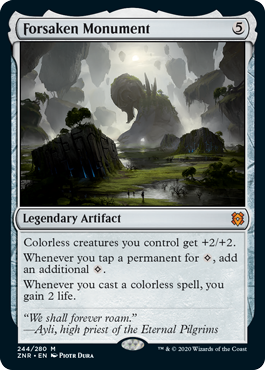
As I said above. We liked having a few small nods to the Eldrazi even though the creatures themselves were gone. While the Eldrazi are gone, the denizens of Zendikar still haven't forgot them or the huge impact they had on the world. The Zendikari still remember.
Zendikar Rising Tides
I hope you have all enjoyed the story of Zendikar Rising's design. As always, I'm eager to hear your feedback, on this article, on Zendikar Rising itself, or on any of the mechanics I've talked about today or last week. You can email me or contact me through any of my social media accounts (Twitter, Tumblr, Instagram, and TikTok).
Join me next week for some Zendikar Rising card-by-card design stories.
Until then, may you have fun playing both sides of the card.
#771: Corey Bowen
#771: Corey Bowen
In this podcast, I interview Corey Bowen, a current member of R&D, one who focuses on Commander design.
#772: Making Magic in the Pandemic
#772: Making Magic in the Pandemic
32:31
Curious how COVID has affected the making of Magic? That's my topic for this podcast.
- Episode 770 Ikoria, Part 2
- Episode 769 Jim Lin
- Episode 768 Ikoria, Part 1

